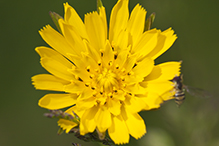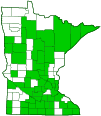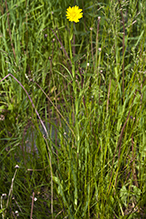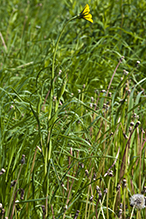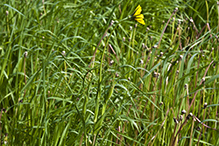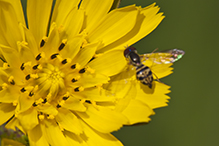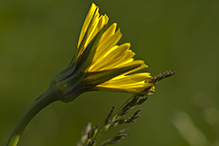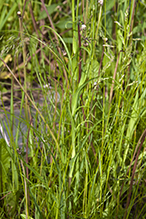meadow salsify
(Tragopogon pratensis)
Conservation • Description • Habitat • Ecology • Use • Distribution • Taxonomy
Conservation Status |
||||||||
| IUCN Red List | not listed |
|||||||
| NatureServe | NNA - Not applicable SNA - Not applicable |
|||||||
| Minnesota | not listed |
|||||||
Description |
||
Meadow salsify is a 16″ to 32″ tall, erect, biennial forb that rises on one or more stems from a fleshy taproot. In its first year it shows only a rosette of basal leaves. In the second year it sends up one to five sparingly branched, sparsely-leaved stems that terminate in a single flowering stalk with a solitary flower head. The stems are erect and usually branched near the top. They are often covered with a whitish, waxy bloom (glaucous). They usually have patches of white, woolly or cobwebby hairs when young and are hairless or almost hairless at maturity. The stems and leaves exude a milky sap when broken. Basal leaves are grass-like, linear, up to 12″ long, and stalkless. They are rounded and wide at the base, up to ¾″ wide, then abruptly narrowed and tapered evenly to the tip. They are sometimes strongly curved backward, often coiled, toward the tip. The upper and lower surfaces are usually glaucous. They are hairy with woolly or cobwebby hairs when young, and hairless or almost hairless at maturity. The margins are untoothed. Basal leaves are sometimes withered by flowering time. Stem leaves are alternate. They surround the stem (clasp) at the base and are otherwise similar to basal leaves. They become progressively smaller as they ascend the stem. The inflorescence is a solitary, 1″ to 2½″ wide flower head at the end on a long, leafless flower stalk (peduncle). The flower stalk is not swollen below the flower head. There are usually 8 bracts at the base of the flower head. The bracts do not extend beyond the outer margin of the rays. Occasionally, there are 12 bracts. There are usually 50 to 110, sometimes more, ray florets. The ray florets are lemon yellow to bright yellow and ⅝″ to 1″ long. The flower heads open in the morning and are closed by the afternoon. The fruiting head is a whitish, spherical pappus, 3″ to 3½″ in diameter, resembling a large dandelion. The peduncle occasionally becomes slightly inflated toward the tip when the plant is in fruit. |
||
Height |
||
16″ to 32″ |
||
Flower Color |
||
Bright yellow |
||
Similar Species |
||
Yellow goat's beard (Tragopogon dubius) leaves are straight, not curved backward or coiled. The peduncle is inflated at the tip when the plant is in flower. There are usually 13, occasionally 8, bracts. The bracts usually extend well beyond the ray florets. The ray florets are pale yellow. It is found in drier habitats. |
||
Habitat |
||
Moderate moisture. Roadsides, railroads, disturbed sites. Full sun. |
||
Ecology |
||
Flowering |
||
May to August |
||
Pests and Diseases |
||
|
||
Use |
||
|
||
Distribution |
||||
|
Sources |
|||
| 5/12/2023 | ||||
Nativity |
||||
Native to western Asia and to Europe. Introduced and naturalized in North America. |
||||
Occurrence |
||||
|
||||
Taxonomy |
|||
| Kingdom | Plantae (Plants) | ||
| Division | Tracheophyta (Vascular Plants) | ||
| Subdivision | Spermatophytina (Seed Plants) | ||
| Class | Magnoliopsida (Dicots) | ||
Order |
Asterales (Sunflowers, Bellflowers, Fanflowers, and Allies) | ||
Family |
Asteraceae (Sunflowers, Daisies, Asters, and Allies) | ||
| Subfamily | Cichorioideae (chicories, dandelions, and allies) | ||
| Tribe | Cichorieae (lettuce, chicory, dandelion, and salsify) | ||
| Subtribe | Scorzonerinae | ||
| Genus | Tragopogon (salsifies) | ||
The use of the name Tragopogon pratensis for the introduced North American species may prove to be incorrect. |
|||
Subordinate Taxa |
|||
|
|||
Synonyms |
|||
Tragopogon lamottei Tragopogon orientalis Tragopogon pratensis ssp. orientalis Tragopogon pratensis ssp. pratensis |
|||
Common Names |
|||
goat’s-beard Jack-go-to-bed-at-noon Johnny-go-to-bed-at-noon lesser goat’s-beard meadow salsify shepherd’s-clock showy goat’s-beard yellow goat’s-beard |
|||
Glossary
Bract
Modified leaf at the base of a flower stalk, flower cluster, or inflorescence.
Clasping
Describing a leaf that wholly or partly surrounds the stem but does not fuse at the base.
Glaucous
Pale green or bluish gray due to a whitish, powdery or waxy film, as on a plum or a grape.
Lanceolate
Lance-shaped; much longer than wide, thickest toward the base, and gradually tapering toward the tip.
Linear
Long, straight, and narrow, with more or less parallel sides, like a blade of grass.
Pappus
The modified calyx composed of awns, scales, bristles, or feather-like hairs in plants of the Aster family such as thistles and dandelions.
Peduncle
The stalk of a single flower or flower cluster.

Visitor Videos |
|||
Share your video of this plant. |
|||
| This button not working for you? Simply email us at info@MinnesotaSeasons.com. Attach a video, a YouTube link, or a cloud storage link. |
|||
Other Videos |
|||
| Oriental Salsify (Tragopogon pratensis subsp. orientalis) - 2012-06-25 W3stlander |
|||
About
Published on Jun 27, 2012 Oriental Salsify (Tragopogon pratensis subsp. orientalis). ------------------ |
|||
| Flower Time Lapse (Samsung SMX-F40) WaveHectorx |
|||
About
Uploaded on Jun 7, 2011 Tragopogon pratensis. |
|||
| The Opening of the Giant Dandelion Camilla Pandolfi |
|||
About
Uploaded on Jun 9, 2011 Meadow Salsify |
|||

Visitor Sightings |
|||||
Report a sighting of this plant. |
|||||
| This button not working for you? Simply email us at info@MinnesotaSeasons.com. Be sure to include a location. |
|||||
|
|||||
MinnesotaSeasons.com Sightings |
|||||

|
Created: Last Updated: © MinnesotaSeasons.com. All rights reserved. |
